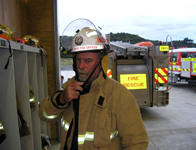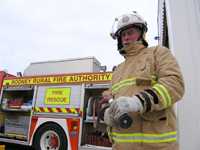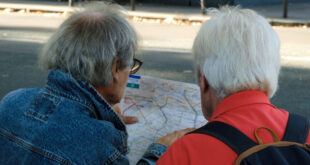Reprinted with permission of ACP Media. NZ Lifestyle Block May 2007 Issue 36
Author: Adele Thackray Photographer: Adele Thackray
Meet mild-mannered farmer Bill Hellyer who can morph at a moment into a life-saving hero, and he’s one of hundreds throughout the country who regularly make the transformation.
 Bill has been with the Kaukapakapa volunteer rural fire service since it was just an idea discussed at a party with professional fire fighter Paul McDonald. Community concern had been sparked by some recent house fires and the pair teamed up to create a solution. It took a few years of community and council meetings, but in 1999, the service began operating, initially from Bill’s barn.
Bill has been with the Kaukapakapa volunteer rural fire service since it was just an idea discussed at a party with professional fire fighter Paul McDonald. Community concern had been sparked by some recent house fires and the pair teamed up to create a solution. It took a few years of community and council meetings, but in 1999, the service began operating, initially from Bill’s barn.
Now the station has its own purpose-built building which was opened in 2004 and is ranked the third busiest rural fire station in the country after attending 76 callouts last year alone. Unlike some rural stations, up to 80 per ent of Kaukapakapa’s callouts are non-fire related, including a high proportion of medical emergencies and car accidents.
“We’re not so much rural as rural/urban,” says Bill. “We don’t get the big scrub fires they get in the South Island or the bush fires they have in Australia, but we do get everything from barn fires and house fires to floods, road fatalities, medical emergencies and trapped horses. Every job is different.”
When he’s not bailing people out of trouble, Bill can be found baling hay, as sub-contractor to a local hay maker, or working on his own 800-acre property where he currently farms beef weaners through to 18-month-old forward condition steers, and heifers for the local trade. One of few remaining large-scale farmers in the area, he was brought up in Kaukapakapa, attended local schools and together with wife Lynda, raised three children there.
His in-depth local knowledge is a great advantage to the force, particularly when it comes to tracking down water supplies. Having worked on a number of properties while hay baling, Bill can be relied on for good information, even in the dark, recently pinpointing a safe landing space for a rescue helicopter in the middle of the night.
Initially elected deputy chief fire officer by fellow firefighters (and under a new system appointed to the position), he is often responsible for directing the fire crew in how to handle an incident as well as providing hands-on help at the scene.
 Chief fire officer, Paul McDonald says Bill’s training and experience, combined with his quietly spoken approach and unflappable demeanour command considerable respect among the crew, while his dry sense of humour is also appreciated.
Chief fire officer, Paul McDonald says Bill’s training and experience, combined with his quietly spoken approach and unflappable demeanour command considerable respect among the crew, while his dry sense of humour is also appreciated.
Though the work is entirely voluntary, Bill says the rewards are great. “We’re trying to preserve life, whether it’s a kiddy with a broken bone or an adult with a heart attack.
We’re trained to cope with both. I get a really positive buzz out of it.”
The station, with two fire trucks and just 14 crew, is currently understaffed after the recent departure of some the area’s fire-fighters. Each truck takes a full crew of six people which means all of the current staff are on call round the clock, seven days a week.
The station is funded for up to 20 fire fighters through the local council (unlike some urban forces which also recruit volunteers but are funded through the New Zealand Fire Service). However, training for both services is equivalent and volunteers are recruited through local advertising and posters. Candidates must be at least 18 years of age and live or work within five kilometres of the station to enable a reasonable response time. Men and women are welcome to apply and there is no upper age limit.
Though Bill’s substantial six-foot-four frame can provide added reach and strength to a job, there is no height restriction and he points out the more diminutive female crew members are ideal for squeezing into a car to help trapped victims. A reasonable level of fitness is required to manage equipment, although Bill says that generally the work is not too physically demanding unless there is a scrub fire which can only be accessed by foot.
Police and medical checks are standard, along with an interview to determine the applicant’s past experience. People come from a wide range of backgrounds as Kaukapakapa’s current team (including an architect, engineer, panelbeater, truck driver, farmer, real estate agent, housewife and professional fire fighter) demonstrates.
“A big question is ‘what does your partner think of this?’ because they can often have a major bearing on your commitment. I would say it requires a minimum of two hours a week upwards. I’m here most nights and probably do eight to 10 hours a week including various paperwork jobs I’ve got to do,” says Bill, whose wife only occasionally threatens to put his bed down at the station.
 New recruits are required to attend a seven day basic training course held periodically by the New Zealand Fire Service and attend brigade weekly training nights. Additional time in evenings and weekends is also spent on specialist training courses including first aid (through St Johns Ambulance); breathing apparatus and driving. Once basic training is complete, volunteers are issued with a uniform and protective clothing and equipment required for the job.
New recruits are required to attend a seven day basic training course held periodically by the New Zealand Fire Service and attend brigade weekly training nights. Additional time in evenings and weekends is also spent on specialist training courses including first aid (through St Johns Ambulance); breathing apparatus and driving. Once basic training is complete, volunteers are issued with a uniform and protective clothing and equipment required for the job.
“Ideally, recruits have done about six months basic training before they go out on jobs but the average new guy at this station goes out on the truck under supervision in about two months, provided they make the standard.”
Jobs are allocated to the station through the emergency 111 system. A siren is triggered at the station and all staff on duty are immediately alerted through pagers that they have with them night and day. If possible, people drop what they’re doing and head straight for the station, but if they can’t leave or are too far away, they phone into the station to let someone know.
“I live just on five kilometres from the station and usually by the time I get there, the first truck has already left. If I can’t get there within 10 minutes I know it’s not worth coming,” Bill says.
Employers are generally supportive of employees who are volunteer firefighters as they bring useful skills into their workplace.
“Generally fire-fighters are very good listeners and very good leaders. Often they work extremely well unsupervised. It’s very much a team business and people have different strengths and weaknesses,” he says.
Although it usually takes a minimum of four firefighters to get a truck on the road, if it’s a medical call or ambulance assistance, the truck can go with two, provided there’s a medic on board. About half the Kaukapakapa crew have done a course in pre-hospital emergency care and the truck carries essential lifesaving equipment including oxygen and a defibrillator. While the fire crew is usually well received at an incident, people are sometimes surprised when they turn up in response to a medical call because the ambulance isn’t available.
“You do get funny looks from some people when they’ve called an ambulance and this big truck pulls up and six people climb out,” says Bill.
 Callouts can take up anything from half an hour to seven hours and sometimes involve working with other fire crews and emergency services. Working in your local community can sometimes make it an uncomfortably personal business.
Callouts can take up anything from half an hour to seven hours and sometimes involve working with other fire crews and emergency services. Working in your local community can sometimes make it an uncomfortably personal business.
“The worst part of the job is rolling up to an accident and it’s someone you know. You’ve just got to take a deep breath, take a step back and do what you’re trained to do. Fatalities are the hardest to deal with, although you do get accustomed to them a little bit, it’s still a shock to the system.”
After a callout the crew take a moment for a coffee or beer at the station and talk about the job. If there’s been a fatality to deal with Bill follows up with each crew member by phone to check how they’re dealing with it. There are support networks and professional counsellors available to the volunteers if required.
“The big thing about our job is that you’ve always got four of five mates with you. You’re not out there on your own.”
While it can be frustrating to be hauled from bed at three in the morning to attend a false alarm, Bill is philosophical.
“Sometimes you get called to an emergency and when you get there the people are sitting up and talking to you, or the house hasn’t burnt down it was just a rubbish fire out the back, but you always leave here expecting the worst and it’s always a good result if you don’t get it.”
Many firm friendships are formed among firefighters and their families who often get together for barbecues and other gatherings, including an annual Christmas party.
There are also a number of support roles for people in the community who aren’t firefighters, including paperwork, computer work, cleaning, turning up for a call to make sure cars have been locked up or providing refreshments for when the firefighters return.
With continuing growth in Kaukapakapa and surrounding areas, Bill sees the importance of the station continuing to increase and, at 54, expects to be part of it for some time to come.
“I’ll probably be doing it for another decade, although I personally believe you can be too old for the job. You might have the skills and experience, but the old legs and lungs give out tramping up those hills.”









Join the Discussion
Type out your comment here:
You must be logged in to post a comment.